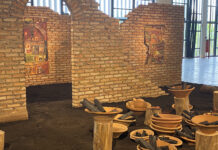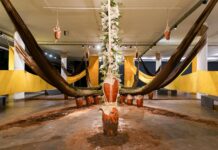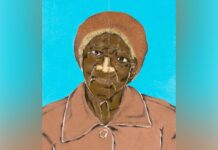
A hybrid between magazine and book, released in digital and free format, Presente is a publication with very unique characteristics in the world of arts. It is not a publication of critical texts or reviews, nor a book focused on images, whether photographs or reproductions of works. It is also not a collection of academic articles, nor even a journal of journalistic language. Presente, a new publication conceived by curator Paulo Miyada and artist Anna Maria Maiolino, focuses on correspondence – or we can call them letters – and “other formats of texts and productions made between two or more people”.
Created in response to the difficult times of the pandemic – in which the need for social distancing, at least physically distanced people -, the magazine appears as a proposition for dialogue and exchanges, as a form of approximation and even care and zeal among the participants . Launched quarterly last April, Presente is the unfolding of the first correspondence exchanged between Miyada and Maiolino in the first months of the Covid-19 pandemic. “In the first half of 2020, when we started to make isolation – at least who could and despite the absence of a State policy in this sense -, I imagined that for artists the suspension of meetings between them, and also of their works with the audience, it would have been difficult”, says Miyada. “And I tried to think about how, despite all the cancellations and suspensions, it would be possible to maintain some level of dialogue with these people.”

That’s when the curator started writing a set of letters to artists he admired and with whom he already had some kind of relationship. Among them was Anna Maria Maiolino, to whom the curator addressed words about that pandemic context, so uncertain, revealing his fears and insecurities, but also commenting on artistic dreams and daydreams. An affectionate dialogue followed with the artist’s response, and the conversation ended up being published on the blog Entretempos da Folha de S.Paulo. “Months later, at the end of 2020, Anna called me and proposed that we do something, a publication or a magazine, a conversation channel not only between us, but now expanded to other people who wanted to think about the present”. With the invitation came the title, as well as the decision that it should be a predominantly correspondence publication.
The name, therefore, refers to the three meanings of the word “present”. First, the current time, “which means putting in the foreground the possibility of art debating its time, being part of a public sphere, in which ethical problems are a fundamental parameter of aesthetic problems”, explains Miyada. This “present time” can only exist, he emphasizes, when looking closely at the past, without making the memory invisible, and having some horizon for the future, “at least the possibility of collective construction and of consequence for individual actions”. Secondly, “present” is the interjection enunciated by students when responding to the school’s call and issued by protesters in an assembly. “And this seems important to me as a beginning of the conversation, assuming that the magazine wants to expand the dialogue beyond the sphere family or private. We are here, thinking out loud about the situation”, says Miyada. Finally, “present” refers to the gesture of giving something, the gift, an important pillar of past and present societies. “It is an exchange regime not based on money, nor on the assumption of infinite accumulation, but based on expenditure and exchange. And I think Presente has a bit of that spirit.”

Another time
As well as distancing itself from academic or journalistic texts, the letter format also proposes a type of conversation that is not that of social networks and applications – with the accelerated dynamics and ephemeral air that are usual for it. For Miyada, the physical distance between people ended up being compensated, somehow, by the use of “certain technological channels that have virtues, but also have vices and tend to emphasize only one type of communication”. And he adds: “Going back to the logic of correspondence, something that takes time to write, to be read, to be answered, is a way of exercising another model, which is not in itself better or worse, but which ends up having a contrasting pace with the means we have been using to communicate”. Presente, in this way, gives space to what Miyada calls “procedural texts”, open, which appear as a way of sharing ideas and dealing with the moment without definitively proposing reflections.
Along with Maiolino and Miyada, the critic and curator Lisette Lagnado, teacher and psychoanalyst Tania Rivera, artists Dalton Paula and Paloma Durante and the artist and dancer Pat Bergantin. Interspersed between sets of correspondences, poetry by Edimilson de Almeida Pereira and visual works by Castiel Vitorino Brasileiro, Fernanda Gomes, Pedro Moraleida appear in the pages of the publication. There is also an unpublished translation of a 1986 essay by the American writer Ursula K. Le Guin. The diversity of fields of activity of the authors of texts and works reflects, therefore, in the multiplicity of themes and languages that run through the magazine, beyond the field of visual arts. But the tying of everything is, once again, in the search for dialogue and in the zeal between people, a kind of care that contrasts with the almost dystopian reality that presents itself on the globe.

“In the contemporary world, what has been exacerbated are very old kinds of violence. From racism, the programmed genocide of indigenous populations, ecocide, environmental attacks, the restriction of freedom of expression. Processes that span centuries, imbricated in the history of Brazil and the world”, says Miyada. “Perhaps what is unique at this moment is what has been called necropolitics, which comes with a perverse rationalization that delegitimizes the right to life, which goes beyond the restriction of citizenship and rights and reaches a banalization of life itself. And we’ve seen this exacerbated in the context of the pandemic, in an even more obscene format.” And he concludes: “So inevitably critical thinking today needs to be done in a way that doesn’t reproduce this contempt for each person’s life – and I think artists, researchers and thinkers are looking for this vocabulary. This is one of the things that appear in the cards from Presente”.
Leia em português, clique aqui.













